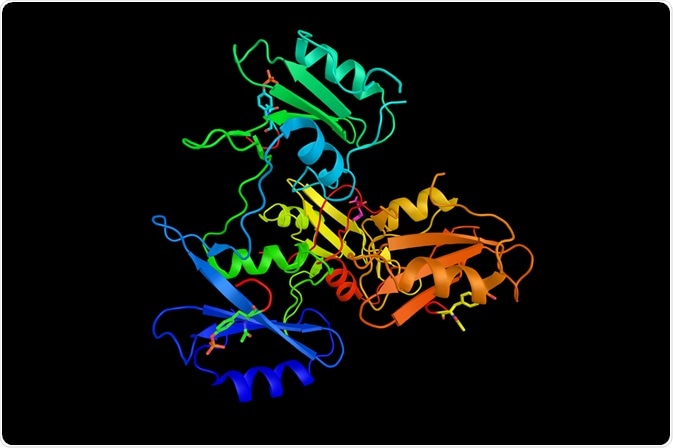How do cells turn into organs?
During embryonic development, three germ layers form, known as the endoderm, the mesoderm, and the ectoderm. These germ layers give rise to different parts of the developing body; the endoderm forms the gastrointestinal tract and associated organs, the mesoderm forms the muscles and skeleton, as well as cardiovascular organs and urogenital organs, and the ectoderm forms the epidermis and neural tissues.
Image Credit: ibreakstock/Shutterstock.com
The process of organogenesis is the formation of organs during embryonic development. This is a coordinated event involving the migration and differentiation of cells to form the “primordium”, which further develops and also undergoes histogenesis until the organ is fully formed.
How does the endoderm develop into organs?
The endoderm is the germ layer that developed into the gastrointestinal tract and glands, as well as other organs that branch off from the gastrointestinal tract.
Formation of the “gut tube”
In both the endoderm and the mesoderm, a tube is formed from a flat sheet of cells. To form the gut tube, the endoderm cells form an anterior intestinal portal (AIP), a crescent-shaped fold arising from the anterior section of the developing embryo. This them moves posteriorly, and another crescent-shaped fold (caudal intestinal portal (CIP)) then forms and moves anteriorly.
The AIP and CIP meet at the yolk sac, where the cells from the anterior end of the embryo form the part of the gut tube rostral to the yolk sac and those that are from the posterior end form the part of the gut tube caudal to the yolk sac. These form the ventral part of the gut tube, and the ventral part of the gut tube is formed by cells in the midline endoderm. Studies in mice have shown that GATA4 is an important transcription factor in gut tube formation.
Formation of the organs
Once the gut tube is formed, cells begin to swell, bud and coil to form the glands and organs; this includes the thyroid and parathyroid, thymus, lungs, liver, and pancreas.
The first process is the thickening of the epithelial layer, which then can either bud off and migrate away from the gut tube to the mesenchymal cells (glands formed from the branchial arches, i.e. thyroid), or remain connected to the gut tube with a duct (liver, gallbladder, pancreas).
Once the position of these organs and glands are established by the changes in the epithelial layer mentioned above, processes such as cell proliferation/death, adhesion and mobility work to form the organs.
Formation of the heart
The heart arises from the mesoderm and is the first organ to be fully functional in the embryo. The process by which the heart forms is conserved across all vertebrates; heart tube formation, rightward looping, and elongation of the heart tube and the formation of cardiac chambers and valves.
Heart tube formation
As in the case of organs derived from the endoderm, the first process in the formation of the heart is the formation of the heart tube. Precursor cells migrate laterally, which creates the anterior lateral mesoderm.
Differentiation and specification of the heart takes place within this region, more specifically the anterior lateral splanchnic mesoderm. This is orchestrated through a range of signaling molecules, including the transcription factor GATA4, and results in the formation of the cardiac crescent.
As the foregut closes, changes occur so that the cardiac crescent changes shape into the heart tube formed of the inner endocardial layer and an outer myocardial layer.
Looping and extension of the heart tube
Once formed, the heart tube then loops to the right – this is the first instance when the right-left axis is established in the embryo. This is accompanied by an increase in heart tube length, driven by the addition of cardiac progenitor cells rather than cell proliferation.
Formation of the cardiac chambers
Controlled expression of a series of genes leads to the formation of the heart chambers; “ballooning morphogenesis” of the looped heart tube results in the growth of the outer curvature, which will eventually form the cardiac chambers. Part of this is through maintaining a lower growth rate in the inner loop.
Septation and formation of the heart valves
Alongside the heart chambers, a “cardiac cushion” is also developed, and this develops into the heart valves.
Another stage in heart development that is necessary for terrestrial life is the separation of the pulmonary and systemic circulation, and this is achieved by the formation of septa within the heart.
Briefly, this occurs by the merging of the ventricular septum, the outflow tract, the atrioventricular septum, and the atrial septum.
Sources
- Solnica-Krezel, L. (2005) Conserved Patterns of Cell Movements during Vertebrate Gastrulation. Current Biology www.cell.com/…/S0960-9822(05)00277-0
- britannica.com Organogenesis https://www.britannica.com/science/organogenesis
- Grapin-Botton, A. and Melton, D. A. (2000) Endoderm development: from patterning to organogenesis. Trends in Genetics www.cell.com/…/S0168-9525(99)01957-5
Last Updated: Mar 26, 2020

Written by
Dr. Maho Yokoyama
Dr. Maho Yokoyama is a researcher and science writer. She was awarded her Ph.D. from the University of Bath, UK, following a thesis in the field of Microbiology, where she applied functional genomics toStaphylococcus aureus . During her doctoral studies, Maho collaborated with other academics on several papers and even published some of her own work in peer-reviewed scientific journals. She also presented her work at academic conferences around the world.
Source: Read Full Article

